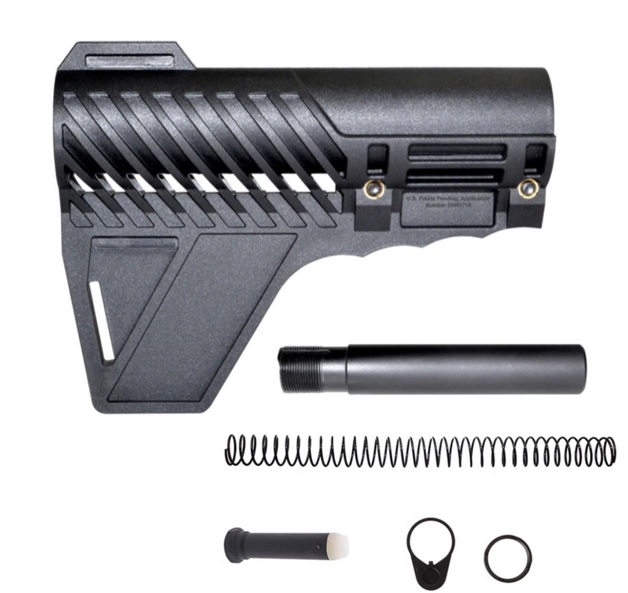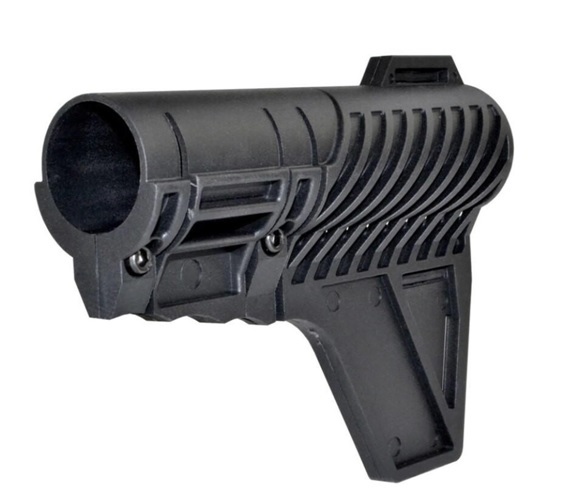Pistol braces: they’ve been at the forefront of quite a bit of controversy, lately, what with the new ATF ruling and all.
Let’s take a closer look at these devices, what they do, and why it might matter for you.
What Is a Pistol Brace? Why Use One?
First and foremost, we need to get to the bottom of what a pistol brace is.
Quite simply, a pistol brace, which is also known as a stabilizing brace, is a component that is attached to the firearm (sometimes but not always to the buffer tube) and then straps to the shooter’s forearm (usually with velcro), stabilizing the firearm. They enable the platforms with which they are paired, primarily AR pistols, to be fired with one hand.
They stabilize the AR pistol, or “brace” it. Hence the name.
Pistol braces are actually new in the world of tactical odds and ends and were first developed in 2012. All pistol braces ultimately trace their origin to the insight of a USMC veteran named Alex Bosco, who, upon witnessing a disabled shooter struggling to control an AR pistol, got it into his head that he could devise a better way.
That he did, by developing the first ever pistol brace which functioned as described above.
And so, interestingly enough, pistol braces were born. Yet, despite the fact they were originally intended for shooters with disabilities, others were quick to notice that braces could drastically enhance the performance and handling of AR pistols.
When shooting an AR pistol with one hand, the balance is terrible and there is a lot of strain on your hand and wrist. Moreover, it’s difficult to control recoil, even in a light caliber.
Pistol braces change all that, shifting some of the pressure to your forearm and taking some of the strain off your grip muscles. In that manner, braces can benefit not only shooters with disabilities, but basically anyone that shoots an AR pistol.
The first two companies to develop and produce stabilizing braces commercially were Century Arms International and Sig Sauer, but in the years that have followed, many other manufacturers have developed their own.

Is a Brace the Same as a Buttstock?
One critical distinction that must be drawn here is that a pistol brace is not the same thing as a butt stock. Let alone the fact that AR stocks are designed to be mounted to a buffer tube system whereas not all braces are, they do not function in the same way.
A pistol brace rests against the user’s forearm and enables the platform to be fired one-handed. It does not contact the user’s shoulder and serves a very different function.
A buttstock rests against the shooter’s shoulder and is designed for shoulder-fired platforms - like rifles, not pistols. A stock is also inherently designed for two-handed, not one-handed, shooting.
Is a Buffer Tube a Pistol Brace?
A buffer tube is not a pistol brace. It is a totally separate component that is necessary for and central to the operation of an AR-style platform.
The buffer tube contains the buffer weights and spring. When you fire the rifle and the bolt carrier group’s lugs unlock, the whole group moves to the rear and enters the buffer tube.
The BCG moves against the buffer weight and compresses the buffer spring, which stores that potential energy which is necessary to return the BCG back into battery.
Though the pistol brace may attach to the buffer tube, it is an entirely separate component.
What Is an AR Pistol?
Since you won’t ever need a part like a pistol brace if you fire a full-sized AR rifle, it pays to draw the differences between an AR pistol and a full-sized, shoulder mounted platform at the outset.
An AR pistol may look like an AR-15 rifle, but it is classified as a handgun and will handle and shoot much more like a handgun than a full-sized rifle.
You may be able to recognize an AR pistol by a few defining traits. For instance, many AR pistols have a handguard around the barrel and load with a magazine in front of the grip, rather than through the grip as in the case of conventional handguns.
AR pistols also may have a rail system around the barrel for mounting shooting accessories, as well as a rifle-style charging handle (rather than a handgun’s slide) as well as an exposed buffer tube system.
AR pistols are a popular alternative to full-sized rifles because they are lighter and more compact, which makes them easier to fire in confined spaces, as well as to store and transport.
The cool factor is another undeniable reason that some people prefer AR pistols over full-sized platforms. There’s just something enjoyable about breaking them out at the range and that’s definitely a reason that some people own and shoot these firearms.
Why Would You Want an AR Pistol Instead of an SBR?
The ATF classifies any rifle with a barrel length of less than 16” as a short-barreled rifle (or SBR) and requires special dispensation and a tax stamp to own one.
An AR pistol is a popular alternative to an SBR, primarily because it does not require a tax stamp or any special red tape to get one. The other reason is that AR pistols are popularly chambered in rifle calibers, just like an AR-15.

Pistol Braces and Other AR Accessories
Whether you have a full-sized AR-15 or prefer to shoot an AR pistol, we have a wide range of accessories, including but not limited to pistol braces.
In addition to our pistol braces, we also carry a full range of AR parts and accessories such as optics, grips, bolt carrier groups, buffer tube systems, and handguards.
We also carry a variety of parts, such as stripped and assembled uppers, necessary for completing your own build at home.
Take a look through our collection and let us know if we can help you find what you’re looking for, at Sales@MCSGearup.com.

